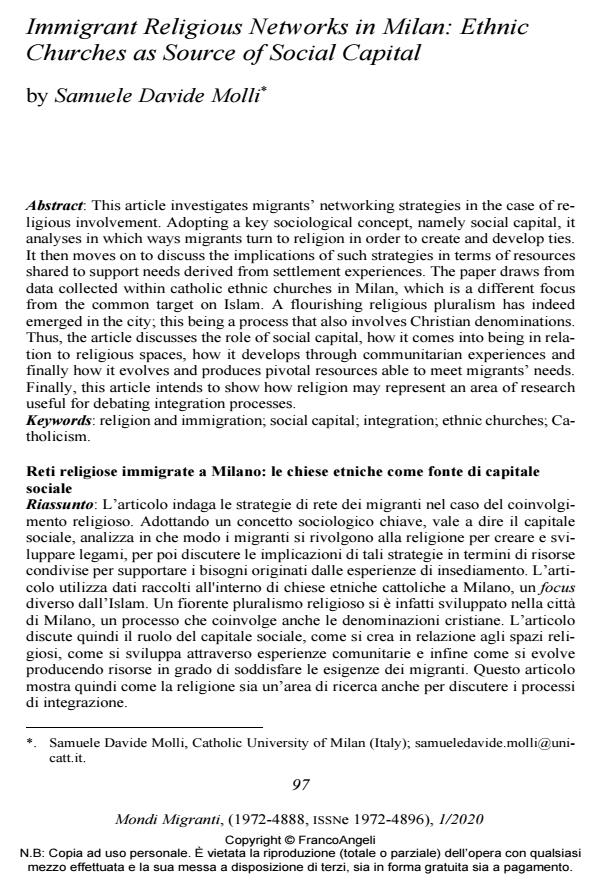Immigrant Religious Networks in Milan: Ethnic Churches as Source of Social Capital
Titolo Rivista MONDI MIGRANTI
Autori/Curatori Samuele Davide Molli
Anno di pubblicazione 2020 Fascicolo 2020/1
Lingua Inglese Numero pagine 20 P. 97-116 Dimensione file 191 KB
DOI 10.3280/MM2020-001006
Il DOI è il codice a barre della proprietà intellettuale: per saperne di più
clicca qui
Qui sotto puoi vedere in anteprima la prima pagina di questo articolo.
Se questo articolo ti interessa, lo puoi acquistare (e scaricare in formato pdf) seguendo le facili indicazioni per acquistare il download credit. Acquista Download Credits per scaricare questo Articolo in formato PDF

FrancoAngeli è membro della Publishers International Linking Association, Inc (PILA)associazione indipendente e non profit per facilitare (attraverso i servizi tecnologici implementati da CrossRef.org) l’accesso degli studiosi ai contenuti digitali nelle pubblicazioni professionali e scientifiche
This article investigates migrants’ networking strategies in the case of religious involvement. Adopting a key sociological concept, namely social capital, it analyses in which ways migrants turn to religion in order to create and develop ties. It then moves on to discuss the implications of such strategies in terms of resources shared to support needs derived from settlement experiences. The paper draws from data collected within catholic ethnic churches in Milan, which is a different focus from the common target on Islam. A flourishing religious pluralism has indeed emerged in the city; this being a process that also involves Christian denominations. Thus, the article discusses the role of social capital, how it comes into being in relation to religious spaces, how it develops through communitarian experiences and finally how it evolves and produces pivotal resources able to meet migrants’ needs. Finally, this article intends to show how religion may represent an area of research useful for debating integration processes.
L’articolo indaga le strategie di rete dei migranti nel caso del coinvolgimento religioso. Adottando un concetto sociologico chiave, vale a dire il capitale sociale, analizza in che modo i migranti si rivolgono alla religione per creare e sviluppare legami, per poi discutere le implicazioni di tali strategie in termini di risorse condivi-se per supportare i bisogni originati dalle esperienze di insediamento. L’articolo uti-lizza dati raccolti all'interno di chiese etniche cattoliche a Milano, un focus diverso dall’Islam. Un fiorente pluralismo religioso si è infatti sviluppato nella città di Mi-lano, un processo che coinvolge anche le denominazioni cristiane. L’articolo discu-te quindi il ruolo del capitale sociale, come si crea in relazione agli spazi religiosi, come si sviluppa attraverso esperienze comunitarie e infine come si evolve producendo risorse in grado di soddisfare le esigenze dei migranti. Questo articolo mostra quindi come la religione sia un’area di ricerca anche per discutere i processi di integrazione. .
Parole chiave:Religione e immigrazione; capitale sociale; integrazione; chiese et-niche; cattolicesimo
- Immigrazione, Religione e Integrazione. Il caso delle comunità sikh e filippine in Lo Samuele Davide Molli, Maurizio Ambrosini, in EDUCATIONAL REFLECTIVE PRACTICES 1/2021 pp.99
DOI: 10.3280/erp1-special-2021oa12470 - Immigrant Women’s Protagonism: Exercising Leadership Roles in Ethnic Churches at the Time of the Pandemic in Italy Samuele Davide Molli, in Religions /2022 pp.696
DOI: 10.3390/rel13080696 - Handbook of the Geographies of Religion Andrew Williams, pp.757 (ISBN:978-3-031-64810-6)
- Migrants’ (Im)mobilities in Three European Urban Contexts Samuele Davide Molli, John Eade, pp.139 (ISBN:978-3-031-53772-1)
Samuele Davide Molli, Immigrant Religious Networks in Milan: Ethnic Churches as Source of Social Capital in "MONDI MIGRANTI" 1/2020, pp 97-116, DOI: 10.3280/MM2020-001006